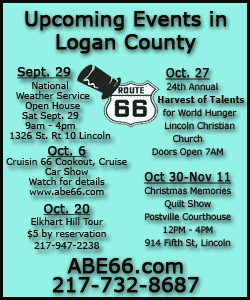 Pierceall was first contacted by the Leo Burnett advertising
company to ask for his assistance in creating the billboard for
one of their clients, McDonald's Corp. -- the goal being to
stress the fresh salads in their menu. "Burnett googled
horticulture and Chicago, and my name kept coming up, so they
called me," said Pierceall. Pierceall was first contacted by the Leo Burnett advertising
company to ask for his assistance in creating the billboard for
one of their clients, McDonald's Corp. -- the goal being to
stress the fresh salads in their menu. "Burnett googled
horticulture and Chicago, and my name kept coming up, so they
called me," said Pierceall.
Pierceall has over 30 years of experience in environmental
education and landscape design. Currently he is adviser of a
horticulture degree-completion program for Chicago-area
students. "They can complete the last two years of a four-year
degree and get a diploma from the U of I without having to move
to Champaign-Urbana," Pierceall said.
The initial request from Burnett was about the feasibility of
growing information in a vertical growing system. "I have always
had an interest in vertical growing and creating 'art' pieces
with plants as growing art, so their request was heaven," said
Pierceall. "So, defining the growing system was the first effort
and then selecting what plants to use. After I knew who the
client was, it was easier to proceed with the investigation and
research part of the design process."

The growing system is patented by a company in Canada. "It's
a framework that provides the vertical growth of plants, kind of
like plant pockets or storage for shoes in a closet," he said.
"It has specific soils, or in this case soil-less soils, to hold
the moisture and allow the plants to grow."
The plants for the billboard were grown by a local grower,
the Good Earth Greenhouse in River Forest, and growing
facilities in Lockport. "Interestingly, the owner of Good Earth
is Regan Cronin, one of my new students in the Chicago
degree-completion program," Pierceall said.

The billboard was mounted in Wrigleyville, near the
intersection of Addison and Clark streets.
Pierceall said that the "shelf life" of the billboard is
unlimited as defined by Mother Nature, and even she can't be
pushed. "The ad agency wanted the billboard to be up this
summer, but I told them it had to wait because lettuce is a
cool-season crop and would never be successful in the summer in
Chicago," he said. "The seasonal nature of the plants defined
the presentation timing and the eventual length of the
presentation, kind of like installation art."
[to top of second column] |
 The art concept of the billboard was that the lettuce
would start out spotty and then grow to solid letters, but Pierceall
said that the direct seeding presented flush letters right away.
"They will get more pronounced and increase in texture and colors of
the greens selected as time goes by," he said. And if you're looking
for truth in advertising… "The actual plants we used on the
billboard (are) a blend of mesclun greens that are used in the
McDonald's salads," said Pierceall.
The lettuce required some tender loving care at the seeding stage
and later establishment at the greenhouse and adoption to the actual
site. "The first week was a shakedown as to plant, in space and the
environment," said Pierceall. "The wind, sun and temperature are
inconsistent -- have to be watched daily. And, lettuce is 90 percent
water and can dry quickly." The Brickman Group was hired to do the
growing management of the system after it was in place.
Pierceall said that not only was this a challenging project for
him as a veteran landscape architect and horticulturist, but he was
able to share the experience with his students. "I teach what I call
active education. I have a plan, but as world and life issues
present themselves, I include those elements actively in my course
work and with students.
"With my teaching between Urbana and Oak Brook weekly, I
cross-pollinate the groups by sharing the design ideas back and
forth with both groups," he said. "In design, we strive to find the
second, third and fourth right answers. How better to see
alternative than to share all the students' ideas. Inherent in
design education is the opportunity to find alternative and
solutions to a single problem in multiple ways."
[Text from file received from
the University of Illinois
College of Agricultural, Consumer and Environmental Sciences]

 |